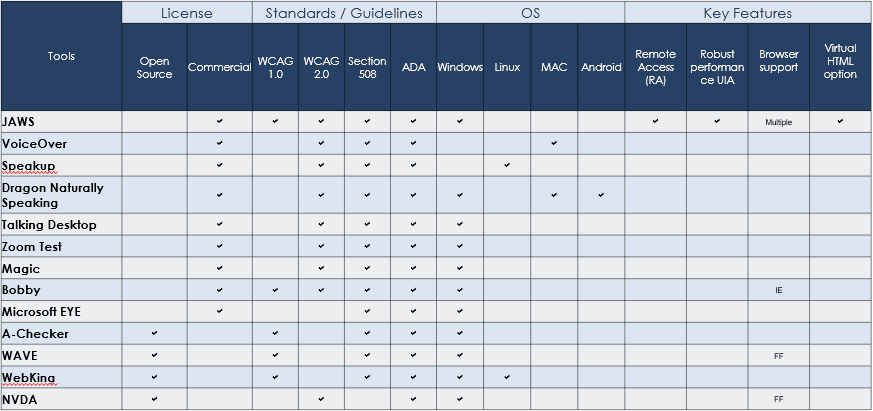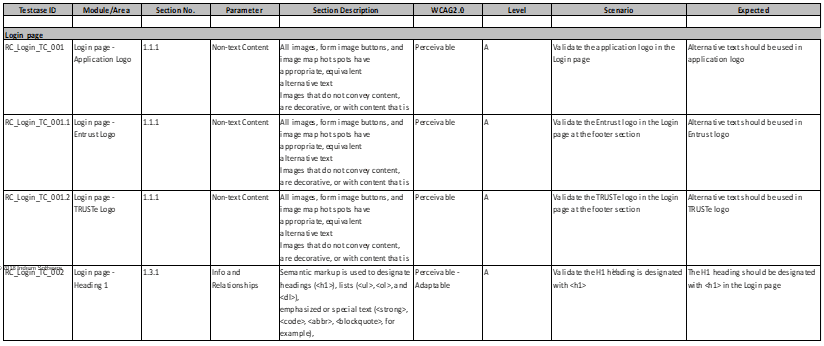- July 26, 2019
- Posted by: Pradeep Parthiban
- Category: Digital Assurance

If you are in the US or if your website is developed for the US audience, then you may have heard about ADA 508 compliance.
The ADA act was first passed in 1990 by the US federal government to prohibit discrimination based on the disability of people.
These disabilities include both mental and physical conditions. For instance, you may have come across wheelchair ramps and automatic door openers for people with a physical disability.
However, the ADA compliance that we will discuss today will be for websites. Under this ADA compliance for websites, it is mandatory for websites to be accessible to all.
What is ADA compliance for websites?
The Americans with Disabilities Act is a compliance regulation published by Departments of Justice in September 2010. This compliance was enacted to protect people with disabilities from discrimination. In simple terms, ADA compliance ensures websites follow a set of agreed accessibility standards.
Is it mandatory for a website to be ADA compliant?
Beyonce Knowles was sued by a blind woman for not being able to access her website beyonce.com without the help of a sighted companion.
Last year alone there were around 1000 lawsuits filed related to website accessibility. Some of the industries affected were eCommerce, restaurants, FMCG. Even big brands like Nike, Hershey’s and Burger King were affected.
The number of lawsuits filed against failing to comply with ADA compliance is alarming. It is best advised for companies to ensure their website is ADA compliant to avoid such drastic consequences.
Apart from legal ramifications, it is a smart business decision to make sure your website is ADA compliant.
You don’t want potential customers to leave your website just because you are not following the ADA standards.
According to the Survey of Income and Program Participation (SIPP), around 54 million Americans have a disability. And this is a huge number. Think ADA as another form of SEO. Here, you optimize your website for people with disabilities instead of optimizing for keywords.
Who needs ADA compliance?
Your website needs ADA compliance if you fall under any of the following categories.
- If your business benefits the public
- If you are a state or government agency
- If you are a private organization with more than 15 employees
How do I make sure my website is ADA compliant?
Your site might already be meeting the standard else it is easy to achieve it with the help of a developer if you know what needs to be done.
For example, you have to make sure all your images have alt-text. This makes it easy for visually impaired people to access the website with the help of screen reader or braille display.
To know whether your website is ADA compliant, a combination of manual testing and test automation is recommended.
Accessibility Tools
There is plenty of software available for you to check the ADA compliance. WAVE is a popular and good tool to check the accessibility of the website.
Though there are tools available at your disposal, it is always advisable to test your website with the help of an experienced QA company as they will have the necessary tools and expertise.
Below is the list of popular accessibility tools available at your disposal.


Now, in order to ensure whether your website is ADA compliant, WCAG (Website Content Accessibility Guidelines) has set guidelines for websites.
The WCAG is part of a series of web accessibility guidelines published by the Web Accessibility Initiative (WAI) of the World Wide Web Consortium (W3C), the main international standards organization for the Internet.
According to WCAG, website content should be:
Now, in order to ensure whether your website is ADA compliant, WCAG (Website Content Accessibility Guidelines) has set guidelines for websites.
Is Your Application Secure? We’re here to help. Talk to our experts Now
Inquire Now
The WCAG is part of a series of web accessibility guidelines published by the Web Accessibility Initiative (WAI) of the World Wide Web Consortium (W3C), the main international standards organization for the Internet.
According to WCAG, website content should be:
- Operable – It should be easy for the users to navigate using mouse and keyboard comments
- Understandable – The website should be easy for users to comprehend information
- Perceivable – The website visitors should be able to process information efficiently such as audio descriptions for all content.
- Robust – Your website should adapt to the changes and evolve. For example, the website should be compatible with screen reading software.
The World Wide Web Consortium (W3C) has set standards for the World Wide Web and its accessibility. Web Content Accessibility Guidelines (WCAG) was created by W3C, which is like Section 508. The WCAG 2.1 is the recently updated version of the standard.
Benefits of ADA Compliance
Though it might seem as not a big deal, there are benefits for keeping your website compliant.
- The first benefit of ADA compliance is you can avoid hefty fines.
- By failing to keep your website ADA compliant, you are missing out the opportunity to connect with millions of potential customers.
- ADA compliance means better SEO. Since accessibility is one of the key criteria used by search engines for SEO. Better SEO leads to more people with and without disabilities finding your website.
- Accessible website means better usability and reputation. By making your site accessible, you are increasing your own “profitability”.
Sample Test Case Template
The goal of test cases is to make sure the behavior and expected results are same. Here is a sample test case template to give you an idea on how accessibility compliance test cases are written.


Conclusion
Periodically testing your website for ADA compliance is necessary to avoid unnecessary hassle and possible legal issues.
There are many other reasons listed above to keep a tab on ADA and WCAG guidelines. To conclude, ADA compliance means, an accessible website for everyone, increased sales and revenue for your business.




